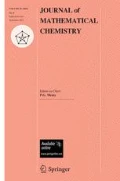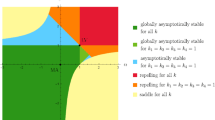Abstract
In this paper, we incorporate stochastic incidence of a chemical reaction into the standard Keizer’s open chemical reaction. We prove that a positive stationary distribution (PSD) for the associated chemical master equation exists and is globally asymptotically stable. We present threshold dynamics of the stochastic Keizer’s model in term of the profile of the PSD for both finite and infinite volume size V. This establishes a sharp link between deterministic Keizer’s model and the stochastic model. In this way, we resolve Keizer’s paradox from a new perspective. This simple model reveals that such stochastic incidence incorporated, though negligible when V goes to infinity, may play an indispensable role in the stochastic formulation for irreversible biochemical reactions.


Similar content being viewed by others
References
E.J. Allen, L.J.S. Allen, H. Schurz, A comparison of persistence-time estimation for discrete and continuous stochastic population models that include demographic and environmental variability. Math. Biosci. 196, 14–38 (2005)
L.J.S. Allen, An Introduction to Stochastic Processes with Applications to Biology, 2nd edn. (CRC Press, Boca Raton, 2011)
L.J.S. Allen, G.E. Jr, Lahodny, Extinction thresholds in deterministic and stochastic epidemic models. J. Biol. Dyn. 6, 590–611 (2012)
L.M. Bishop, H. Qian, Stochastic bistability and bifurcation in a mesoscopic signaling system with autocatalytic kinase. Biophys. J. 98, 1–11 (2010)
P. Childs, J.P. Keener, Slow manifold reduction of a stochastic chemical reaction: exploring Keizer’s paradox. DCDS-B 17, 1775–1794 (2012)
J.R. Chazottes, P. Collet, S. Méléard, Sharp asymptotics for the quasi-stationary distribution of birth-and-death processes. Probab. Theory Relat. 164, 285–332 (2016)
G.E. Jr. Lahodny, Persistence or extinction of disease in stochastic epidemic models and dynamically consistent discrete Lotka-Volterra competition models, Ph.D. dissertation, Texas Tech University, Lubbock, Texas, 2012
M.Y. Li, C. Xu, A limit threshold theorem for a Markov chain SIS epidemic model, preprint
I. Nåsell, The quasi-stationary distribution of the closed endemic SIS model. Adv. Appl. Probab. 28, 895–932 (1996)
I. Nåsell, Extinction and quasi-stationarity in the Verhulst logistic model. J. Theor. Biol. 211, 11–27 (2001)
O. Ovaskainen, B. Meerson, Stochastic models of population extinction. Trends Ecol. Evol. 25, 643–652 (2010)
Z. Schuss, Theory and Applications of Stochastic Processes: An Analytical Approach (Springer, New York, 2010)
H.M. Taylor, S. Karlin, An Introduction to Stochastic Modeling, 3rd edn. (Academic Press, New York, 1998)
M. Vellela, H. Qian, A quasistationary analysis of a stochastic chemical reaction: Keizers paradox. Bull. Math. Biol. 69, 1727–1746 (2007)
M. Vellela, H. Qian, Stochastic dynamics and non-equilibrium thermodynamics of a bistable chemical system: the Schlögl model revisited. J. R. Soc. Interface. 6, 925–940 (2009)
C. Xu, Strong Allee effect in a stochastic logistic model with mate limitation and stochastic immigration. DCDS-B 21, 2321–2336 (2016)
Y. Zhang, H. Ge, H. Qian, Vant Hoff-Arrhenius analysis of mesoscopic and macroscopic dynamics of simple biochemical systems: Stochastic vs. Nonlinear bistabilities (2010), arXiv:1011.2554
Acknowledgements
The author is indebt to Professor Hong Qian at the University of Washington, Seattle, for bringing reference [5] to the author’s attention. The author is also indebt to one anonymous referee for bringing references [7, 12] to the author’s attention, and appreciates both of the anonymous referees’ valuable comments and suggestions which greatly improve the presentation of this paper. This research was supported in part by China Scholarship Council Visiting Scholarship, University of Alberta Doctoral Recruitment Scholarship, Pundit RD Sharma Memorial Graduate Award, Eoin L. Whitney Scholarship, Josephine Mitchell Graduate Scholarship and Pacific Institute for the Mathematical Sciences(PIMS) Graduate Scholarship.
Author information
Authors and Affiliations
Corresponding author
Appendix: Proofs of main results
Appendix: Proofs of main results
Proof of Theorem 4.1
By (3.1),
If \(R_0\leqslant 1,\) by (5.1) and assumption \(\mathrm{(H1)},\)
which proves (a).
Now suppose that \(R_0>1\). From (5.1), to find \(n_{\max }\), we need to locate n for \(p^s_{n+1}=p^s_n\). Denote by \(n_{\pm }/V\) the roots of the following quadratic equation for every \(n\in {\mathbb {N}}:\)
Notice that the limits \(n_{\pm }/V\) as \(V\rightarrow \infty \) satisfy
i.e.,
In fact, by regular perturbation theory and \(\mathrm{(H1)},\) it is straightforward to deduce that
Let \(n_{\min }\in \left\{ \left[ \frac{1}{R_0-1}\right] ,\left[ \frac{1}{R_0-1}\right] +1\right\} \) be such that \(p^s_{n_{\min }}=\min \left\{ p^s_{\left[ \frac{1}{R_0-1}\right] },p^s_{\left[ \frac{1}{R_0-1}\right] +1}\right\} \) and \(n_{\max }\in \left\{ \left[ x_*V-\frac{R_0}{R_0-1}\right] ,\left[ x_*V-\frac{R_0}{R_0-1}\right] +1\right\} \) be such that \(p^s_{n_{\max }}=\max \bigg \{p^s_{\left[ x_*V-\frac{R_0}{R_0-1}\right] },\) \(p^s_{\left[ x_*V-\frac{R_0}{R_0-1}\right] +1}\bigg \}.\) Then the monotonicity of \(p^s\) follows:
Finally, for all large V, \(p^s_{n_{\max }}>p^s_0\) follows from \(\lim _{V\rightarrow \infty }\frac{p^s_{n_{\max }}}{p^s_0}=+\infty ,\) implied by Propositions 5.1 and 5.2 below. \(\square \)
Proposition 5.1
Let \(\psi \) be defined in (4.1).
-
(a)
If \(R_0\leqslant 1,\) then \(\psi (x)\) is decreasing and thus \(\psi (x)<0,\ \forall \ x\in (0,+\infty ).\)
-
(b)
If \(R_0>1,\) then \(\psi (x)\) is increasing in \((0,x_*)\) and decreasing in \((x_*,+\infty ).\)
Proposition 5.2
Assume that \(\mathrm{(H1)}\) holds. Then for every \(\lim _{V\rightarrow \infty }\frac{n}{V}=x>0,\)
Moreover, assume \(\mathrm{(H2)}\) holds, then
in particular, if \(\underset{V\rightarrow \infty }{\lim }\frac{n_1}{V}=x_1>0\) and \(\underset{V\rightarrow \infty }{\lim }\frac{n_2}{V}=x_2>0,\) then
Proof
Note that
By \(\mathrm{(H1)},\)
which implies (5.3). If \(\mathrm{(H2)}\) holds, then
Thus the first three terms of RHS of (5.6) vanish as \(V\rightarrow \infty .\) The last term is the Riemann sum for the integral \(\psi (x).\) This proves the proposition. \(\square \)
Proof of Theorem 4.2
We only prove case (b). Case (a) can be proved using similar arguments. Let X be the number of species X, a random variable. In the following, it suffices to show that, for all sufficiently small \(\delta \in (0,x_*),\)
It follows from Proposition 5.1 that \(\psi \) achieves its positive maximum at \(x_*.\) By (5.5), there exists \(V_0:=V_0(\delta )>0\) such that \(\forall \ V>V_0,\)
and
Note that \(\psi (x_*)>0.\) By continuity of \(\psi ,\) assume without loss of generality that \(\psi (x_*\pm \delta )>0\) and \(\delta <\min \left\{ x_*,\frac{k_2}{k_{-1}}\right\} \). Hence by Theorem 4.1 (b), there exists \(V_1>V_0,\) such that for all \(V>V_1,\)
and
By \(\mathrm {(H1)},\)
Then it follows from \(\delta <\frac{k_2}{k_{-1}}\) that
Hence for all \(V>V_1,\)
with \(d=\min \{\psi (x_*)-\psi (x_*-\delta ),\psi (x_*)-\psi (x_*+\delta )\}>0.\) This shows that (5.7) \(\square \)
Rights and permissions
About this article
Cite this article
Xu, C. Threshold dynamics of a stochastic Keizer’s model with stochastic incidence. J Math Chem 55, 1034–1045 (2017). https://doi.org/10.1007/s10910-016-0730-8
Received:
Accepted:
Published:
Issue Date:
DOI: https://doi.org/10.1007/s10910-016-0730-8



